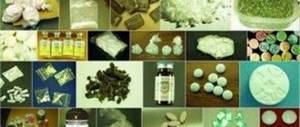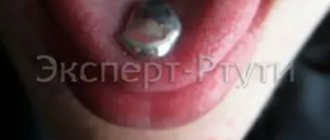Mercury thermometers are used to determine body temperature and are an integral part of a home medicine cabinet. The advantage of the device is its high accuracy - up to 0.01 degrees. The downside is the toxicity of the liquid metal and its health hazard. Mercury poisoning from a thermometer is common in medical practice.
Mercury is very dangerous for the body
Characteristics of poisoning
Excessive concentrations of vapors or mercury compounds in the human body cause poisoning. It is impossible to say exactly how much is needed for poisoning. There is no minimum dose of intoxication. Any amount is dangerous for humans, especially women and children. A concentration of 0.25 mg/m3 provokes disturbances in the functioning of the respiratory system. A dose of 35 ng/ml in the blood already causes negative consequences in humans, which can cause severe illness.
You can be poisoned by inorganic metal compounds and organic forms. Elemental mercury is present in thermometers, filling material and sphygmomanometer. Salts are hidden in many types of plastics; small concentrations are present in the medicine Calomel and in some food products. The organic form is found in paint, cosmetics, medicines and foods. Bacteria are known that can form mercury salts - they are mainly found in fish.
Elementary compounds enter the body as part of vapor, enter the respiratory tract and then penetrate the bloodstream. With the blood, toxic fumes spread into organs and tissues. The substance is absorbed into the stomach tissue, oxidized and bound to certain groups of proteins. The toxin is eliminated through feces and urine, partly through the lungs. In 2 months, only half of the substance will be released.
Inorganic compounds penetrate tissues through the digestive organs. In this case, the mucous membrane of the organs suffers and only then the poison moves on. Salts are concentrated mainly in the kidneys, a small amount is distributed to other organs. The output is similar to elementary connections, but the speed is slightly higher - 1.5 months.
Due to their high coefficient of fat solubility, methylated salts easily penetrate the placenta and can accumulate in breast milk. The substance reacts with hemoglobin and moves through the bloodstream along with red blood cells. The nervous system, kidneys and circulatory system are suppressed to a greater extent. Urine removes the toxin for about 2.5 months.
In the International Classification of Diseases (ICD-10), poisoning is listed under code T56.1.
Treatment
Treatment involves eliminating any exposure to the metal and limiting sources of exposure.
If mercury poisoning is related to work or environmental exposure, doctors may suggest changing locations to reduce exposure to mercury vapor or implementing new workplace safety measures.
Mercury poisoning can cause some long-term side effects that are considered individually.
Certain types of severe cases of mercury poisoning may require chelation therapy. This is the process of removing mercury from the organs.
The drugs used in chelation therapy bind to heavy metals in the bloodstream and then remove the mercury through the urine. Chelation therapy has its own risks and side effects, so it is extremely important to use the medication only when needed.
Signs of mercury poisoning
Signs of poisoning more often appear when the density of the toxic substance in the blood exceeds 500 ng/ml.
The indicated symptoms of mercury poisoning characterize the acute principle of intoxication:
- A strong suffocating cough appears;
- There is a slight tremor in the hands;
- Severe headaches accompanied by dizziness;
- Nervous state – the patient is very excited;
- There is pain in the larynx when swallowing food;
- There is a pressing pain in the area of the heart;
- There is a pronounced taste of metal in the mouth against the background of high salivation;
- The victim rapidly develops pneumonia;
- The gums bleed heavily - foci of inflammation appear;
- A person gets very chilled at a body temperature of 38-40 degrees;
- Complete lack of appetite;
- There are acute attacks of nausea with vomiting - sometimes there is blood in the masses;
- Intense diarrhea with bloody discharge;
- Tissue necrosis develops in the intestines and kidneys;
- Nephrotic syndromes are rapidly developing;
- Dehydration of the body.
The accumulation of mercury vapor over a long period of time can cause chronic poisoning of the body (mercurialism). The condition is dangerous because the body has systematically received poison, which provoked irreversible processes in the tissues. The process can last from 5 to 10 years.
Symptoms characterizing chronic damage to the body by toxin:
- A person constantly feels tired in the body and muscle weakness;
- Lack of response to external stimuli – apathy;
- There is profuse salivation;
- Poor appetite or lack thereof, which leads to weight loss;
- A vomiting attack is always accompanied by nausea;
- Frequent urination;
- Inflammatory foci develop on the gums - stomatitis, tooth loss without pain can occur;
- The victim has difficulty with smell and taste, numbness in certain areas of the skin;
- Tremor of the upper extremities gradually shifts to the legs and other parts of the body;
- Constant pain in the head with dizziness;
- The mood is characterized by an excited state, turning into irritability;
- Short-term memory loss due to decreased mental activity;
- Depending on the psychotype, insomnia or, conversely, increased drowsiness occurs;
- Soft tissues with signs of swelling and increased sweating;
- Photophobia develops rapidly;
- A rash of various types is observed on the skin;
- Blood pressure is set at extremely low levels;
- Chronic disturbances in the functioning of the heart are recorded.
Prevention
To exclude the possibility of mercury poisoning from a thermometer with subsequent dangerous symptoms, you must remember safety precautions and carefully use devices containing mercury. It is especially important that children do not play with them, since their symptoms and treatment are much more difficult.
If it is not possible to call the SES, then you should carefully clean the place where the disaster occurred. It is important not only to seal all the substance and objects in contact with it, but also to wash all surfaces with a weak solution of potassium permanganate. It is recommended to ventilate the room well during the week.
The benefits and harms of a mercury thermometer
To measure body temperature, a lot of different devices have been developed, but nothing better than a mercury thermometer has yet been invented (this is what doctors themselves say). But accidentally breaking a thermometer, people cause themselves a lot of troubles that threaten their health. From a broken thermometer, mercury scatters around the room in small balls, which then spread throughout the apartment. Vapor from a broken thermometer fills the air in the apartment - this is the most dangerous thing, because... intoxication occurs from fumes.
Inhalation of toxic fumes for a long time leads to irreversible processes in the body. The first signs may appear in a month, or maybe in a year. The kidneys and nervous system are suppressed to a greater extent. The degree of damage to other organs depends on the density of the contaminated air and the time that the body inhaled the poison.
It is not always easy to understand that poisoning occurred from a thermometer that broke accidentally. The first symptoms are very similar to overwork. The further development of signs helps to determine - involuntary trembling of the hands and eyelids with lips.
In children and pregnant women, contact with toxic fumes can cause serious complications. For a child, for acute intoxication, a 1.5-fold excess of the norm is enough; from a broken device, the excess of the norm is fixed at 100–200 times. The toxin easily penetrates the placenta of a pregnant woman and often causes the development of chronic pathologies in the fetus. The presence of animals in the apartment makes the situation many times worse. Mercury often remains on the fur, which is dangerous for the pet and its owner.
To prevent complications, you need to carefully collect the scattered mercury from the thermometer, destroy it according to the instructions, and ventilate the contaminated room. The mercury will completely disappear in a month or three, but within 3 days the concentration will decrease significantly.
Unacceptable things when breaking a thermometer
Many people do not know what to do correctly when a thermometer with mercury breaks; they take the wrong steps, which worsen the situation several times.
What not to do:
- It is prohibited to dispose of fragments and means of collecting the substance with other household waste - the threat of contamination of a large area with a toxic substance increases.
- Throw mercury balls into the toilet, sink or cesspool - particles will remain on the insides of the pipes, which is dangerous for further poisoning.
- Clothes that have been in contact with the toxin should be washed in a washing machine - they must be disposed of.
- Vacuuming the room to quickly collect the balls will increase the evaporation of the poison many times over.
- Collect the toxin with a broom - the mercury particles will become even smaller, making collection more difficult.
Procedure for collecting mercury
- If a room is poisoned with mercury, it is necessary to thoroughly ventilate it and close access to the interior. During the heating season, you need to turn off the heating - this will slow down the evaporation of the toxin. Ventilation time is at least 60 minutes. It is necessary to immediately notify the concerned services about the incident. It is advisable to invite specialists who will professionally carry out the necessary activities. If there is no such opportunity, do everything yourself.
- The skin must be protected from contact with toxic balls - gloves, gauze bandages and shoe covers. You will need a glass container with a tight lid filled with a chlorine-containing solution. You also need to take tape, a syringe, a syringe, wet paper (2 sheets), plasticine, and wire. The cotton pad and brush should be damp. Before starting collection, it is recommended to examine the room with a flashlight and mark areas with mercury with chalk or pencil. On a flat surface it is convenient to collect with paper or a brush with a cotton swab - sweeping one on top of the other. In hard-to-reach places, a syringe and syringe are useful. It is convenient to collect microscopic particles with tape or plasticine. You definitely need to get the mercury out of the cracks - a wire and a syringe will help. Pour all the balls into a container with the solution.
Mercury in water
- After collection, the room needs to be treated. You will need a solution of potassium permanganate with 1 tbsp. salt and vinegar mixed with a liter of warm water. Moisten the areas where metal is present with the prepared solution and leave for 2 hours. You need to wash off potassium permanganate with a soap solution - dilute 40 g of soap and 50 g of soda in water (1 liter). You can use chlorine bleach - 1 liter diluted with 5 liters of water. Mercury contamination can be neutralized with iodine. It is recommended to treat the room within 7-14 days - the window must be open.
- The mercury must be tightly closed with a lid. Collect all items that come into contact with metal in a tight bag. And all this must be handed over to an organization specializing in the disposal of hazardous chemical waste.
- After the measures taken, it is necessary to take preventive measures to prevent your own poisoning. Rinse your mouth and throat with a weak solution of potassium permanganate. Brush your teeth thoroughly and drink activated charcoal (3 tablets). Drink plenty of fluids - the kidneys will remove the toxic substance. Such prevention will help avoid possible consequences.
Non-standard situations
If mercury gets on an open area of the skin, you need to carefully collect all the particles and wash with a soapy solution and warm water. Irritation at the site of the lesion must be shown to a doctor.
If by chance a child gets mercury inside, immediately provoke vomiting and call an ambulance. A ball of metal will not cause harm - it will gradually leave the body in a standard way.
The mercury remains inside the thermometer - place it in a container with water and give it to disposal specialists.
After a broken thermometer there are no traces of poison - urgently call employees who specialize in working with mercury. It is necessary to measure the air for the presence of toxic vapors.
Disposal of a broken thermometer
If you accidentally break a thermometer, there is no need to be alarmed. The following recommendations must be followed:
Without panicking, determine the exact location: where exactly the thermometer crashed.- Everyone should leave the premises, including animals, except those who have mercury residue on their fur or clothing.
- Open windows to allow fresh air to enter. Doors should be closed to avoid drafts that will carry mercury vapor into adjacent rooms.
- To protect against respiratory vapors, wear a moistened gauze bandage, as well as rubber gloves and shoe covers.
- Scoop up the mercury balls with a sheet of paper and pour them into a jar of cold water. Small drops are collected with adhesive tape, wet newspaper or tape. The dangerous substance is sucked out from hard-to-reach places with a syringe or syringe. If necessary, remove the baseboards.
- All things with which mercury has come into contact are collected in a plastic bag and disposed of. The floor and all smooth surfaces are wiped with potassium permanganate or bleach.
- The jar of mercury should be handed over to the relevant authorities, checking with the Ministry of Emergency Situations.
- All clothing and utensils that were used when collecting mercury should also be disposed of.
If cleaning requires a large amount of time, you need to take a break every 15 minutes and go out into the fresh air from the room.
Possible complications
What consequences of mercury poisoning will appear depends on the amount of poison that the person inhaled:
- Respiratory pathologies – lung failure;
- The presence of constant pain in the head;
- Decreased vision and hearing, difficulty speaking;
- Loss of coordination;
- Short-term amnesia;
- In pregnant women, it can provoke the development of pathologies in the fetus - cerebral palsy, cerebellar atrophy;
- Muscle paralysis;
- Mental disorder - insanity;
- Deep coma and death.
Causes of intoxication
There are several sources of infection with toxic mercury vapors:
- Broken mercury thermometer;
- Mercury-zinc batteries;
- Energy-saving lamps;
- Bulbs filled with mercury;
- Lamps containing mercury vapor;
- Medicinal drugs - Calomel, Sublime or Mercuzal;
- Dental fillings containing metal;
- Seafood with high toxin content;
- Industrial accidents;
- Presence of metal at abandoned production sites.
Using metal in everyday life
Mercury is widely used in chemical production and in everyday life. It is a strong toxic substance that, when evaporated, forms toxic fumes. It is found quite often in everyday life - these are mercury lamps, heating and energy-saving appliances, and a mercury thermometer.
The thermometer contains approximately two grams of mercury. For a person, the lethal dose is half the amount of mercury in a thermometer. If you break a thermometer, liquid metal in the form of small silvery and very mobile balls can penetrate into all the hard-to-reach corners of the apartment. It will not be easy to get them, and if they are not neutralized soon, the release of toxic fumes will begin in the room after a while under the influence of warm temperatures.
We also recommend reading:
Signs and treatment of alcoholic coma, first emergency aid Help for a dog poisoned by rat poison Intoxication of the body: home treatment methods Abdominal pain and diarrhea: what to do if your stomach hurts
First aid
How much mercury poisoning is needed depends on the physical characteristics of the person. The time when intoxication manifests itself varies from person to person. It is necessary to call doctors. Before the team arrives, it is recommended to provide assistance at home:
- Remove the victim immediately from the contaminated area.
- Rinse the stomach with a weak solution of potassium permanganate - you will need 3 or 4 liters. You need to drink 1 liter of liquid once - this will cause vomiting. In case of absence, provoke it yourself.
- Rinse your mouth and throat with manganese solution.
- Enter the antidote - Unithiol.
- Give a laxative tablet.
- Provide the patient with plenty of fluids.
Providing first aid often helps prevent the development of dangerous complications in victims. Only doctors can say how long it took for the poisoning to appear.
Traditional medicine
With a mild degree of intoxication, you can cleanse the body of mercury vapor using folk remedies. To do this, you need products that will help the liver cope with detoxification:
- Rice - in any form binds toxins. If you are poisoned, you should stick to a rice diet for some time. In this case, it is necessary to exclude fried, salty and spicy foods from the diet. A tablespoon of cereal is poured with boiling water (half a glass) and left to swell for two to three hours. You should get a crumbly porridge that should be eaten on an empty stomach. You can start your main meal after two hours.
- Beetroot contains a lot of flavonoids that bind heavy metals. Eating 300 grams daily. beets in any form, you can get rid of mercury vapor poisoning.
- Sea kale. This product contains unique substances that neutralize mercury - alginators.
- Oats are a storehouse of nutrients. Helps cleanse the body of all harmful substances and toxins.
- Potato. Thanks to the starch content, it absorbs toxins, removes waste from the body, and binds heavy metals.
- Herbal decoctions of rose hips, calendula and chamomile increase the liver's protective mechanism and cleanse the body of toxins. You should drink them instead of coffee and tea.
Some types of berries and fruits containing pectin also have antitoxic properties. Eating pears, apples, apricots, blackberries and raspberries helps cope with poisoning.
The main measure to prevent mercury intoxication is to eliminate exposure to the harmful compound. Having broken a thermometer or fluorescent lamp, you must immediately take all actions to eliminate the accident. It is important for people employed in hazardous industries to undergo regular medical examinations and rinse their mouths with a solution of potassium chlorate or permanganate.
Diagnostics
Diagnosis is carried out in a hospital - this will help to adjust the treatment of an adult and a child, and will help to find out the extent of damage to the body by toxic fumes. The first test results may show normal values, because... mercury poisoning will appear after 14 days. Therefore, the diagnosis is repeated after a given period of time:
- It is mandatory to donate blood for general and biochemical analysis;
- Urine and feces for analysis of the presence of mercury;
- Ultrasound examination of the digestive organs and kidneys;
- The hairline is examined with a special solution.
Drugs for drug therapy
To treat mercury poisoning in modern medicine, special medications are administered intravenously, the therapeutic effect of which is aimed at binding the toxin in the blood and eliminating it in the urine. This treatment is carried out in a hospital setting using one of the following drugs:
- D-Penicillamine is a strong anti-inflammatory drug that is not prohibited for kidney disease;
- Unitol - binds mercury compounds. This remedy should not be used if you have a stomach ulcer or high blood pressure;
- Strizhevsky's antidote;
- Succimer - helps with poisoning, but contains a strong allergen;
- sodium dimercaptopropanesulfonate;
- Thetacine-calcium is an effective drug for inhalation mercury intoxication;
- Sodium thiosulfate is a strong antitoxic, desensitizing and anti-inflammatory agent.










